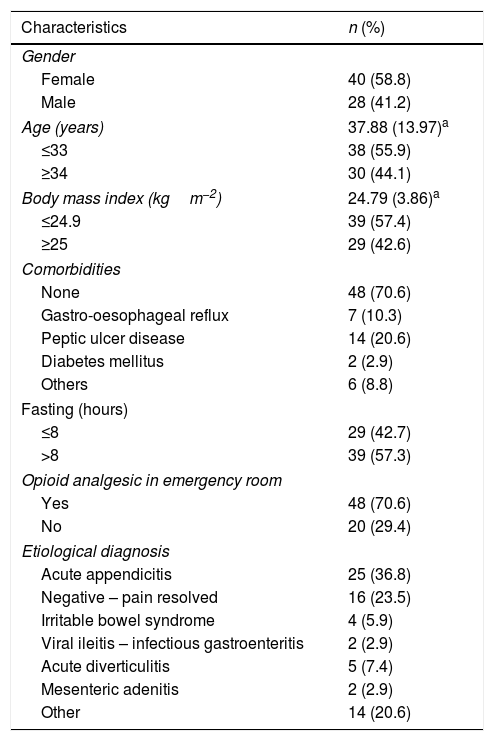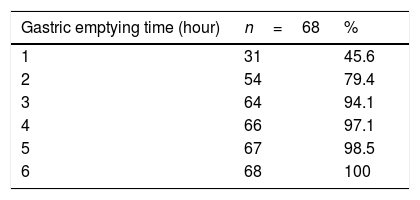Practice guidelines for preoperative fasting have not clearly established the fasting time needed after oral administration of water-soluble contrast media. The aim of this study was to determine the time required for the gastric emptying during the water-soluble contrast media in patients with acute abdominal pain.
MethodsThis prospective longitudinal study included sixty-eight patients older than 18 years of age with acute abdominal pain, who required a water-soluble contrast media enhanced abdominal computed tomography study. Plain radiographs were obtained hourly until complete the gastric emptying. Patients with probable bowel obstruction were not included in the study.
ResultsA total of 31 (45,6%), 54 (79,4%), and 64 (94.1%) patients achieved a complete gastric clearance of barium in 1, 2 and 3h, respectively. All patients achieved complete emptying of water-soluble contrast media within 6h. Gastric emptying time was not associated with gender (P=0.44), body mass index (P=0.35), fasting time prior to water-soluble contrast media intake (P=0.12), administration of opioids in the emergency room (P=0.7), and the presence of comorbidities (P=0.36).
ConclusionNinety-four percent of the patients with acute abdominal pain achieved complete gastric emptying within 3h after the administration of water-soluble contrast media. All of them achieved complete gastric emptying within 6h. The results suggested 6h after oral intake of the contrast media is enough to complete transit of water-soluble contrast media through the stomach and avoid unnecessary risks.
En la actualidad, las guías de práctica clínica para ayuno preoperatorio no han establecido claramente el tiempo de espera necesario tras la administración de un medio de contraste hidrosoluble. Nuestro objetivo fue determinar el tiempo requerido para el vaciamiento gástrico posterior a la administración de un medio de contraste hidrosoluble en pacientes con abdomen agudo.
Materiales y métodosEste estudio longitudinal prospectivo incluyó 68 pacientes, mayores de 18 años, con abdomen agudo, a quienes se administró un medio de contraste hidrosoluble para la realización de una tomografía abdominal. Se obtuvieron radiografías cada hora hasta completar el vaciamiento gástrico del medio de contraste. Se excluyeron pacientes con sospecha de obstrucción intestinal.
ResultadosTreinta y uno (45,6%), 54 (79,4%) y 64 (94,1%) pacientes alcanzaron la eliminación gástrica completa de bario en 1, 2 y 3 h, respectivamente. La totalidad de los pacientes alcanzó el vaciamiento gástrico completo dentro de las 6 primeras h. No se encontraron diferencias respecto al género (P=0,44), índice de masa corporal (P=0,35), tiempo de ayuno previo al contraste (P=0,12), administración de opioides en urgencias (P=0,7), ni presencia de comorbilidades (P=0,36).
ConclusiónEl 94% de los pacientes con abdomen agudo alcanzaron el vaciamiento gástrico completo dentro de las primeras 3 h posteriores a la administración de medio de contraste. A las 6 h, la totalidad de los participantes habían aclarado el medio de contraste. Consideramos relevante esperar las 6 h de ayuno posteriores a la ingesta oral del medio de contraste para asegurar el tránsito completo a través del estómago y evitar riesgos innecesarios.










